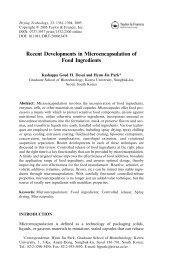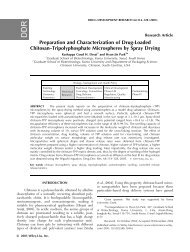Youngjae Byun, Jin Bong Hwang, Sung Hwan Bang
Youngjae Byun, Jin Bong Hwang, Sung Hwan Bang
Youngjae Byun, Jin Bong Hwang, Sung Hwan Bang
Create successful ePaper yourself
Turn your PDF publications into a flip-book with our unique Google optimized e-Paper software.
In this research, poly 3-caprolactone (PCL) was used to encapsulate<br />
a-tocopherol within nanospheres. PCL is semi-crystalline<br />
biodegradable and biocompatible polyester with low glass transition<br />
temperature and melting point (Pitt, 1990). It has been investigated<br />
for drug delivery for several years and it is non-toxic and<br />
non-mutagenic (Forrest, Zhao, Won, Malick, & Kwon, 2006; Mora-<br />
Huertas, Fessi, & Elaissari, 2010). Moreover, it is considerably lower<br />
cost than other biodegradable polyesters such as polyglycolide,<br />
polylactide, and their copolymers.<br />
The objective of this work was to entrap a-tocopherol within<br />
PCL nanoparticles by O/W emulsion solvent evaporation with<br />
ultrasonification method and to optimize the encapsulation<br />
formulation. To achieve this goal, this study was designed to assess<br />
the influence of formulation variables on the characteristics of<br />
nanoparticles such as encapsulation efficiency, a-tocopherol<br />
loading, particle size, zeta potential, and morphology. The formulation<br />
variables were as follows: (1) solvent in the oil phase;<br />
(2) concentration of PCL; (3) ultrasonification time.<br />
2. Materials and methods<br />
2.1. Materials<br />
a-tocopherol (Mw 430.7 g/mol) was purchased from EMD<br />
Bioscience (CA, USA). Poly 3-caprolactone (PCL, Mw 65,000 g/mol)<br />
was purchased from SigmaeAldrich (MO, USA). Polyvinyl alcohol<br />
(PVA, Mw 22,000 g/mol) was purchased from Acros organics (NJ,<br />
USA). Methylene chloride (DCM), methanol, and acetonitrile (ACN),<br />
all HPLC grade were purchased from J.T.Baker (USA). Phosphate<br />
Buffered Saline (PBS, 10 liquid concentrate) was purchased from<br />
EMD Bioscience (CA, USA).<br />
2.2. Formulation of nanoparticles containing a-tocopherol<br />
In this study, nanoparticles were prepared using an oil-in-water<br />
emulsion solvent evaporation with ultrasonification technique<br />
(Fig. 1) by modification of previous works (Kim, <strong><strong>Hwan</strong>g</strong>, Park, &<br />
Park, 2005 and Konan et al., 2002). Three factors were statistically<br />
examined, solvent in the oil phase, PCL concentration, and<br />
ultrasonification time (Table 1).<br />
In this procedure, specific amount of PCL (300 or 500 mg) was<br />
dissolved in 10 mL of solvent (methylene chloride or methylene<br />
chloride:acetonitrile ¼ 50:50) containing 10 mg of a-tocopherol.<br />
A PVA (2g/100 mL) solution was prepared in PBS solution. The<br />
PCL solution was added to 40 mL of the PVA solution. The total<br />
mixture in 250 mL centrifuge bottle was then placed in an ice bath<br />
and emulsified using a Branson Digital Sonifier (model 250, Connecticut,<br />
USA) with 55 W of energy output for a specific time<br />
(1, 2, and 3 min) to obtain an oil-in-water emulsion. Another 40 mL of<br />
the PVA solution was then added to the emulsion. The final solution<br />
was stirred for 12 h at 300 rpm on a magnetic stir plate to allow the<br />
evaporation of methylene chloride and acetonitrile and to allow<br />
the formation of the nanoparticles. The suspension was then<br />
centrifuged at 4880 g for 20 min. The pellet was resuspended in<br />
distilled water and centrifuged three more times at 1220 g for 20 min<br />
each. These washing steps were performed to remove unencapsulated<br />
PVA and a-tocopherol. The nanoparticles were collected and<br />
frozen at 80 C for at least 2 h and subsequently freeze dried for 2<br />
days. The freeze dried nanoparticles were stored at 4 C.<br />
2.3. a-Tocopherol encapsulation efficiency (%) and loading (%)<br />
Encapsulation efficiency was determined by an extraction<br />
method. Dried nanoparticles (10 mg) were dissolved in 5 mL of<br />
methylene chloride and 5 mL of distilled water. The mixture was<br />
Y. <strong>Byun</strong> et al. / LWT - Food Science and Technology 44 (2011) 24e28 25<br />
Fig. 1. Flow chart depicting the encapsulation process.<br />
vigorously vortexed for 1 min and sonicated 5 min in order to<br />
extract the a-tocopherol into the organic solution. Then, methylene<br />
chloride was evaporated and replaced with methanol. The 2 mL of<br />
organic solution was filtered and the a-tocopherol content of the<br />
solution was analyzed by HPLC (Waters 1525 Binary HPLC pump,<br />
USA).<br />
The experiment was performed in triplicate and the encapsulation<br />
efficiency was calculated using the ratio of the mass of<br />
Table 1<br />
Batch compositions used for constituting a-tocopheroleloaded nanoparticle.<br />
Code PCL concentration<br />
(g/100 mL)<br />
3M1 3 DCM a<br />
Solvent in the oil<br />
phase<br />
3M2 3 DCM 2<br />
3M3 3 DCM 3<br />
5M1 5 DCM 1<br />
5M2 5 DCM 2<br />
5M3 5 DCM 3<br />
3MA1 3 DCM:ACN b<br />
1<br />
3MA2 3 DCM:ACN 2<br />
3MA3 3 DCM:ACN 3<br />
5MA1 5 DCM:ACN 1<br />
5MA2 5 DCM:ACN 2<br />
5MA3 5 DCM:ACN 3<br />
a DCM: Methylene chloride, ACN: Acetonitrile.<br />
b (DCM:ACN): DCM:ACN ¼ 50:50.<br />
Ultrasonification<br />
time (min)<br />
1




